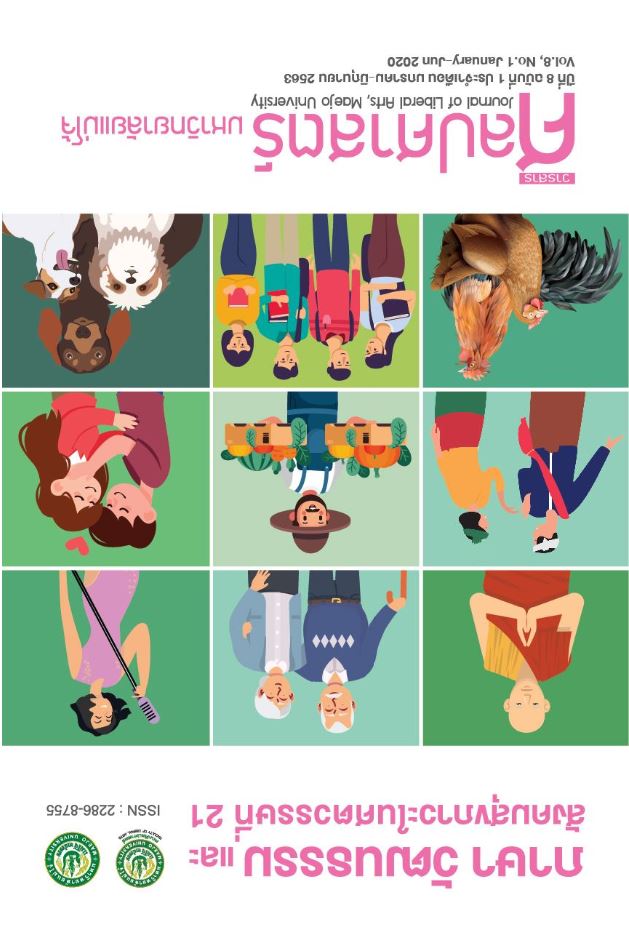The Self Transformation Ritual in Course of Life of The Lua Borluang in Hot District of Chiang Mai: A study in Folklore Approach
Main Article Content
Abstract
This study aims to investigate the recovery ritual ceremony of the “Self Transformation”, via the ritual for welcoming the first son of the noble family or the ritual of invited protecting spirit to return the first child’s body of the Lua Borluang, an ancient ethnic group in Hot district, Chiang Mai province. The concepts and theories of folklore study and structural functionalism were used in the
analysis of the structure of the social relations system and the role of ritual. Results of the study reveal that the ritual happening under the social class relationship structure of the ethnic group and common sense in the traditional cosmology system is the pattern of the negotiation of power. It is the competition for gaining social power and spiritual area between the principal wife who is in the ruling class and the minor wife who is an ordinary citizen of the Lua ethnic group. This competition is the reproduction of the meaning of power of the minor wife who comes from the lower class. It is performed through the ritual of welcoming the first son of the family. This represents the community relation system reflecting through power and competition. The ritual of invited protecting spirit to return the first child’s body which aim to protect the life of the first new man member of a powerful family relies on sacrificial animals that are valuable to sacrifice ancestral spirits in exchange for preserving the life of the new member. It is the negotiation with supernatural powers through the ceremony to show that the new born child has already changed his previous life into this new life. The ritual also encourages the parents that the child can recover from any illnesses. The reproduction of negotiation of power and competition between the social class is through this ritual to achieve the balance of social power for the peace of the community.
Article Details
References
ไกรศรี นิมมานเหมินท์. (2527). ลายคราม. เพื่อเฉลิมฉลองอายุครบ 6 รอบนายไกรศรี นิมมานเหมินท์
โครงการจัดตั้งพิพิธภัณฑ์อารยธรรมลุ่มน้ำโขง มหาวิทยาลัยแม่ฟ้าหลวง. (2551). บทบาทและพิธีกรรมของการทำนายที่มีผลต่อการดำรงชีวิตของกลุ่มชาติพันธุ์ลัวะ (ปลั้ง) ในหมู่บ้านห้วยน้ำขุ่น อำเภอแม่ฟ้าหลวง จังหวัดเชียงราย. เชียงราย : ชอบพิมพ์
ฉวีวรรณ ประจวบเหมาะ และคณะ. (2555). ปริศนาวงศาคณาญาติ “ลัวะ”. กรุงเทพฯ: ศูนย์มนุษยวิทยาสิรินทร
ชลธิรา สัตยาวัฒนา. (2530). ลัวะเมืองน่าน. กรุงเทพฯ: เมืองโบราณ
ไชยรัตน์ เจริญสินโอฬาร. (2555). สัญวิทยา โครงสร้างนิยม หลังโครงสร้างนิยม กับการศึกษารัฐศาสตร์. พิมพ์ครั้งที่ 2. กรุงเทพฯ: วิภาษา
ทรงศักดิ์ ปรางค์วัฒนากุล และ สรัสวดี อ๋องสกุล (บรรณาธิการ). (2561,). สังคมพหุวัฒนธรรม. เชียงใหม่: วนิดาการพิมพ์
เธียรชาย อักษรดิษฐ์. (2552). พิธีกรรมฟ้อนผี : ภาพสะท้อนปรากฏการณ์ต่อรองอำนาจทางสังคม. เชียงใหม่: ธารปัญญา
ปฐม หงส์สุวรรณ. (2550). กาลครั้งหนึ่ง: ว่าด้วยตำนานกับวัฒนธรรม. กรุงเทพฯ: สำนักพิมพ์แห่งจุฬาลงกรณ์มหาวิทยาลัย
ปฐม หงส์สุวรรณ . (2556). นานมาแล้วมีเรื่องเล่า นิทาน ตำนาน ชีวิต. กรุงเทพฯ: สำนักพิมพ์แห่งจุฬาลงกรณ์มหาวิทยาลัย
ประคอง นิมมานเหมินท์, ยรรยง จิระนคร,ศิราพร ณ ถลาง, สุกัญญา สุจฉายา. (2560). คติชนคนไทในวัฒนธรรมข้าว. กรุงเทพฯ: สถาบันไทยศึกษา จุฬาลงกรณ์มหาวิทยาลัย
พิพัฒน์ กระแจะจันทร์.(2561). “ลัวะ” ในหน้าประวัติศาสตร์โบราณคดีล้านนา”. ใน ทรงศักดิ์ ปรางค์วัฒนากุล และสรัสวดี อ๋องสกุล (บรรณาธิการ). สังคมพหุวัฒนธรรม. เชียงใหม่: วนิดาการพิมพ์
ภัททิยา ยิมเรวัต. (2544). สิบสองจุไท. กรุงเทพฯ : สร้างสรรค์
มูลนิธิสารานุกรมวัฒนธรรมไทย ธนาคารไทยพาณิชย์ (2542). สารานุกรมวัฒนธรรมไทย ภาคเหนือ. กรุงเทพฯ : สยามเพรส แมเนจเมนท์
รังสรรค์ จ้นต๊ะ. (2552). บ้าน โหล่ง และเมือง: เขตความสัมพันธ์บนฐานเศรษฐกิจและวัฒนธรรมชุมชนในแอ่งเชียงใหม่–ลำพูนตอนบน. เชียงใหม่: ธารปัญญา
ศิราพร ณ ถลาง. (2548). ทฤษฎีคติชนวิทยา : วิธีวิทยาในการวิเคราะห์ตำนาน–นิทานพื้นบ้าน. กรุงเทพฯ: โครงการเผยแพร่ผลงานทางวิชาการ คณะอักษรศาสตร์ จุฬาลงกรณ์มหาวิทยาลัย
สมัคร บุราวาส (2525). ปัญญาวิวัฒน์ ภาค 1 กำเนิดและวิวัฒนาการแห่งปัญญาของมนุษยชาติในอดีต. (พิมพ์ครั้งที่ 2). กรุงเทพฯ: สำนักพิมพ์แพร่พิทยา
อรรถจักร สัตยานุรักษ์. (2560). โครงการ ความเปลี่ยนแปลง “ชนบท” ในสังคมไทย: ประชาธิปไตยบนความเคลื่อนไหว (รายงานวิจัยฉบับสมบูรณ์). กรุงเทพฯ: สำนักงานกองทุนสนับสนุนการวิจัย.
อานันท์ กาญจนพันธุ์. (2555). คิดอย่างมิเชล ฟูโกต์ คิดอย่างวิพากษ์ จากวาทกรรมของอัตตบุคคลถึงจุดเปลี่ยนของอัตตา. เชียงใหม่: สำนักพิมพ์มหาวิทยาลัยเชียงใหม่
Bascom, W. (1984). The Forms of Folklore: Prose Narratives. In Alan Dandes (ed.). Sacred Narrative: Readings in the Theory of Myth. London: University of California Press.
Durkheim, C. (1915). The Elementary Forms of the Tirligious Life. New York: Free Press
Dundes, A. (1980). “Texture, Text, Context”: Interpreting Folklore. Bloomington: Indiana University Press. pp. 20 – 32
Eberhardt, N. (2007). Imagining the Course of Life: Self–Transformation in a Shan Buddhist Community. Thailand: Silkworm Books
Le’vi – Strauss, C. (1963). “The Structural Study of Myth”, Structural Anthropology. New York: Basic Books.
Rugchat J. (2018). Transformation to “Entrepreneur” of Lua Highlanders: A case study of Lua Ban Na Fon in Hot District, Chiang Mai Province. (Doctoral dissertation). Chiang Mai: Chiang Mai University

